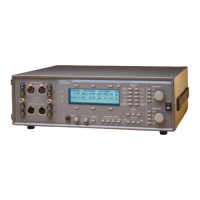Jitter is created by the jitter generator. The jitter modulator then
modulates the clock signals that drive the AES/EBU transmitter so that
the jitter is applied to the output data stream.
The digital analyzer section begins with a multiplexer (MUX) which
automatically selects among the digital signal sources. From there, the
signal passes into an AES/EBU receiver which collects the data and
clock signals from the digital data stream. The data is sent directly to
the DSP for calculation of readings based on the embedded audio.
The clock signals are used to detect jitter on the interface, to detect the
sample rate, and to calculate delay from the output or reference. The
jitter detector’s output is sent through an A/D converter and converted
to values that the DSP can use for jitter readings.
The raw data signal is also sent to an AC-to-DC converter which
detects the amplitude of the digital signal and converts it to a DC
voltage. This voltage is then sent to an A/D converter, which converts
it to digital data which can be used by the DSP to give signal
amplitude readings.
The reference input is coupled to a sync detector which extracts the
clock signals from the digital stream. These clock signals can be used
for delay calculations and to synchronize the output to the reference.
A multiplexer (MUX) chooses which signal is sent to the Digital Trigger
Output. Several important clock signals are available, as well as a
signal directly from the DSP, which is synchronous with the digitally
generated waveform.
The monitor signals are fed by digital audio samples directly from the
DSP, which takes the samples from the appropriate point in its
calculations according to the measurement function. These signals are
converted to analog waveforms by a D/A converter, and then they are
sent to the rear panel INPUT MONITOR and READING MONITOR
connectors in digital analysis modes.
1 Description
Block Diagrams Description
1-14 ATS-1 Dual Domain User's Manual

